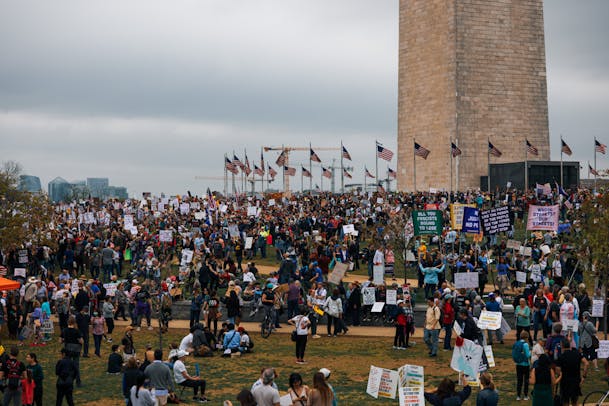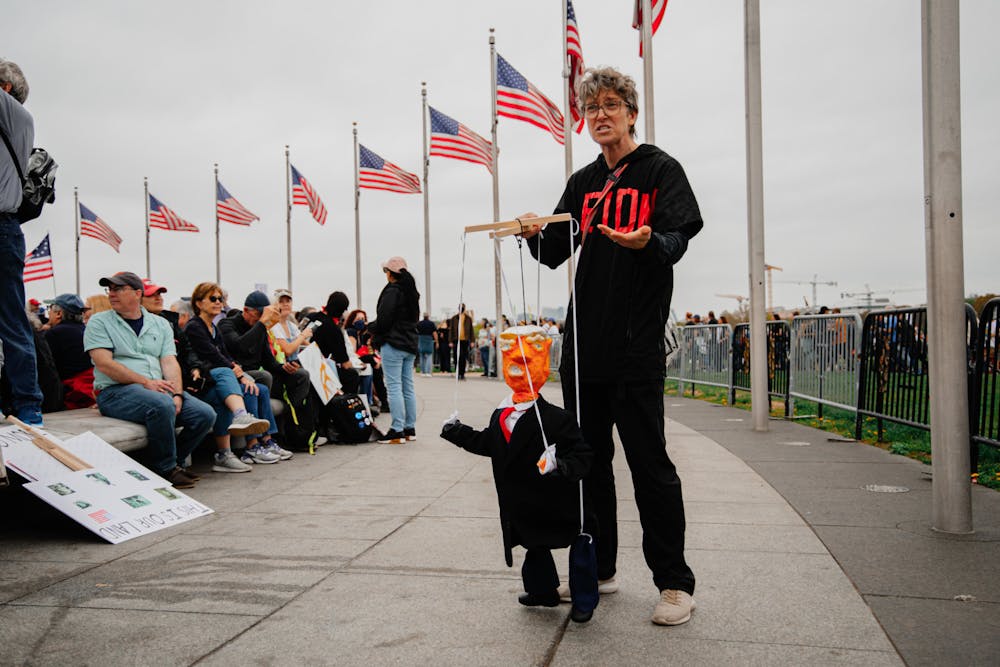Beylen Curtis felt an unexpected surge of school pride on the American University shuttle bus last Saturday as she made her way downtown to an anti-Trump protest.
“When I was taking the wonk to Tenleytown, everyone had signs,” Curtis said. “It was wonderful and it made me … weirdly proud to be here.”
Curtis, a sophomore in the School of Public Affairs, was one of the thousands of protesters who attended the “Hands Off!” rally in downtown D.C. on April 5.
Hundreds of thousands of people across the United States participated in protests against the administration of President Donald Trump. According to organizers, over 1,300 “Hands Off!” protests occurred in major cities and at state capitals and federal buildings around the country..
Besides all 50 U.S. states, protests took place globally, including in Paris and London, according to CNN.
Hands Off! is a grassroots movement committed to nonviolence and opposing Trump, Elon Musk and “their billionaire cronies,” who “are orchestrating an all-out assault on our government, our economy, and our basic rights” and are “enabled by Congress every step of the way,” according to the website. The movement has nearly 200 partners, including Women’s March, the American Civil Liberties Union and Planned Parenthood.
The District’s protest began around 12 p.m. and spanned across the National Mall, with the Washington Monument as its epicenter.
The issues at hand drew in a diverse crowd with varying signs, chants and fears. Throughout the sea of people, LGBTQ+ and Palestinian flags flew alongside homemade Trump and Musk caricatured puppets. Many other signs called for education funding, support for federal workers, protection of immigrants and more.
Kelly Laird and Emily Peck came from Rockville, Maryland to protest the actions of Trump and Musk. Both Laird and Peck worked at the U.S. Agency for International Development and lost their jobs because of the Department of Government Efficiency’s dismantling of federal agencies.
“We’re pissed off about [losing our jobs] and pissed off about USAID being dismantled … and now people are dying, literally, dying without that support,” Laird said.
Voter suppression was another issue that concerned many protesters. Peck described it as “the scariest part.”
Days after the protest, the House of Representatives passed the Safeguard American Voter Eligibility Act. This Republican-led legislation would require voters to provide proof of U.S. citizenship and would make voting by mail more challenging. Some advocacy groups say it could disenfranchise millions of Americans if it passes in the Senate.

“As a country that has been promoting democracy across the world, we're losing our own democracy,” Peck said.
While many current and past federal workers gathered in the crowds to protest, multiple democratic House representatives took the stage to speak to the protesters. Democratic Rep. Jamie Raskin of Maryland began the string of congressional speeches, followed by others such as Democratic Rep. Ilhan Omar of Minnesota and Democratic Rep. Maxwell Frost of Florida. They all spoke from the National Sylvan Theatre on the grounds of the Mall.
The representatives touched on a variety of issues ranging from social security to gun violence to tariffs. Frost considered his responsibility as an elected official and told the crowd to “use all the power that you got.”
Carleigh Haris and Sarah O’Donnell, graduate students at the University of Maryland pursuing masters in public policy, shared Frost’s sentiments. While both Haris and O’Donnell expressed feelings of hopelessness about trying to enter the workforce at a time when many federal workers are losing their jobs, they also recognized the power they have to make a change.
“We talk a lot about the doom and gloom in our classes, but we also talk about how we're gonna fix it because we're going into politics,” O’Donnell said.
The crowd of protesters spanned generations; many families gathered on the Mall with their young children. Elisabeth Staal and Rob McCarthey protested with their nine-month-old son, who rested in his stroller behind a small sign that read “Fund PBS, end fascism.”
“We were nervous to bring [our son] because we feel less safe protesting with Trump in office,” Staal said, “But ultimately want him to know that when things are wrong you need to say something.”
Jean Stuk traveled solo from Phoenix, Arizona to protest in the nation's capital. Stuk carried around a deflated balloon figurine of Donald Trump and dragged it through the crowd with a rope attached to its neck.
“I wanted to come out here to Washington and drag his ass down the streets,” Stuk said.

This passion and anger is what brought so many people to downtown D.C. Shane Sibley, an active recent protester in the district, saw this protest as just the beginning of a larger movement. “It’s growing, obviously,” he said. “It’s gonna be a thing.”
Sibley became involved in protests happening in the District within the last few months. He keeps up with the schedule through Reddit pages, Discord and Facebook.
The current administration’s “authoritarian” and “fascist” actions, as he described them, are what fueled Sibley to begin protesting.
“A lot of people are scared about this, there’s a lot of, I’d say, fearmongering going on,” Sibley said. “I think that’s a narrative trying to be pushed by the administration for sure, right? Scaring them, make them feel hopeless, and I think the protests are a good way to show people [that] you’re not alone.
Though demonstrations occurred nationwide and across the Atlantic, many saw something particularly meaningful about protesting in D.C.
“Something that my grandmother loves to say is that, when you’re in Washington, D.C., your local news is national news,” Curtis said. “I think every single corner that we turn or every direction that we look, something politically is going on. And it’s not only affecting me, but it’s affecting my peers and my counterparts.”
Showing up on behalf of others is what inspired Curtis and many more to trek to the Mall on an overcast afternoon.
“I think having a voice and privilege to protest and exercise that right is something that, unfortunately, not a lot of people are able to do or get to do,” Curtis said.
“If we don’t fight now, there won’t be anything left to save,” reads the Hands Off! website.
Correction: This article has been updated to accurately reflect the number of protesters that gathered in D.C. The headline on a previous version of this article indicated “hundreds of thousands” gathered at the National Mall. It has been updated to reflect that thousands gathered on the mall while hundreds of thousands gathered across the country in various Hands Off! protests.
This article was edited by Abigail Hatting, Maya Cederlund, Tyler Davis and Walker Whalen. Copy editing done by Luna Jinks, Olivia Citarella, Sabine Kanter-Huchting and Hannah Langenfeld.





